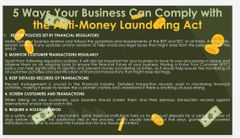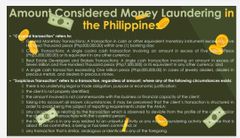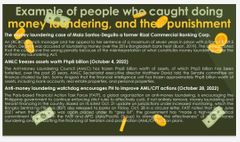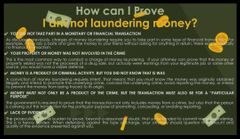![]()
![]()
![]()
Use LEFT and RIGHT arrow keys to navigate between flashcards;
Use UP and DOWN arrow keys to flip the card;
H to show hint;
A reads text to speech;
29 Cards in this Set
- Front
- Back
|
money laundering |
the practice of taking illegally obtained funds and passing them off as legitimately earned cash. Individuals or businesses involved in ____ may use money remittance centers, banks, and/or digital payment systems to move illegally obtained funds to other regions. |
|
|
money laundering |
the illegal process of making large sums of money derived from illegal activity, such as drug trafficking, robbery, extortion, or terrorist financing, appear to have originated from a legal source. Criminally-obtained funds are considered “dirty,” and the laundering process makes them appear “clean.” |
|
|
anti-money laundering |
Money laundering is a serious financial crime employed by white-collar and street-level criminals. Most financial companies today have __ (AML) policies to detect and prevent this activity |
|
|
cryptocurrency |
Money laundering is omnipresent and found in areas where it might least be expected. The advent of ___, such as bitcoins, has exacerbated this phenomenon. |
|
|
placement layering integration |
THREE STAGES OF MONEY LAUNDERING |
|
|
1. placement |
Money laundering begins by moving the criminal proceeds into a legitimate source of income. It might be moved into financial instruments or bank accounts. At this stage, anti-money laundering procedures would focus on sniffing out illegitimate sources of funds. Criminals are vulnerable during the first stage because they are moving a large bulk of money and placing it directly into the financial system. |
|
|
placement |
Here are a few typical tactics used during the __ stage: Creating false invoices Putting money into cash-based businesses Opening foreign bank accounts Creating offshore companies Moving small amounts of money at a time |
|
|
LAYERING |
This involves breaking down large bulk funds into a series of smaller transactions. The idea is that these smaller transactions fall under the threshold of anti-money laundering regulations and would not set off any alarms. Layering often takes place across borders to make it more difficult for anti-money laundering officials to detect foul play. also known as structuring |
|
|
LAYERING |
Tactics might include: Trading in international markets Purchasing foreign money orders Trading in foreign currencies Purchasing and selling luxury assets |
|
|
integration |
the funds are integrated back into the criminal’s legitimate financial accounts. As with earlier stages, this typically involves a series of smaller transactions. For example, the funds might have been used to purchase a luxury asset such as jewelry or property. The luxury asset can be sold, and this creates a trail of legitimately sourced funds. |
|
|
integration |
They might also use tactics like: Putting fake employees on the payroll Paying out loans to directors of a shell company Paying dividends to shareholders of criminal-controlled companies |
|
|
SMURFING |
Also referred to as structuring, criminals break a large number of funds into small chunks of cash, making multiple transactions and spreading the amount to different accounts, making it hard to detect the origin. |
|
|
ELECTRONIC MONEY |
There are many ways where criminals can acquire money, whether by infusing malware, phishing, account hackers, or other vectors. Stored value cards are often used to launder such illegal money by purchasing items from that money. |
|
|
OFFSHORE ACCOUNTS |
Individuals with unexplained excess credits place such money into bank accounts of countries with less or no jurisdiction related to anti-money laundering. The no-disclosure policy in those tax haven countries makes the criminals feel safe, defeating the law. |
|
|
MONEY MULES |
Cash smugglers who help carry illegal cash across different countries and deposit that cash in countries with less stringent tax laws are equally liable as the money launderer is. |
|
|
CASINOS |
Money launderers buy chips from the casinos with their cash and later get those chips exchanged with checks provided by the casinos, sometimes without betting or gambling. |
|
|
CRYPTOCURRENCIES |
The newly inserted online transacting currency in the form of cryptos such as Bitcoin and several others has increased the chances of money laundering. Increasing amounts of OTC trade might result in the heavy transfer of funds between countries. The lack of strict KYC norms in some cryptocurrencies has also acted as an invitation to money laundering. |
|
|
OTHER MONEY-LAUNDERING METHODS |
Such real estate transactions include undervaluation or overvaluation of properties, buying and selling properties in rapid succession, using third parties or companies that distance the transaction from the criminal source of funds, and private sales |
|
|
Anti-money laundering (AML) |
refers to the web of rules, regulations, and processes to identify attempts to mask criminal payments as legitimate revenue. |
|
|
RA 9160 |
The Anti-Money Laundering Act (AMLA) of 2001 or __ criminalizes unlawful activities such as graft and corrupt practices, fraudulent practices, robbery and extortion, swindling and plunder, amongst other activities. |
|
|
okay |
Anti-Money Laundering Act of 2001 (AMLA) is the primary anti-money laundering law in the Philippines. AMLA empowers authorities to investigate money laundering and other financial crimes, therefore protecting financial institutions and discouraging criminals from utilizing the Philippines as a money-laundering destination. |
|
|
✔ Banks, trust entities, and other institutions regulated by the Bangko Sentral ng Pilipinas (BSP); ✔ Insurance companies; ✔ Brokers, salespeople, and investment agents; ✔ Closed-end investment and pre-need companies (e.g., memorial chapels, schools); ✔ Money changers, payment, remittance, and transfer companies; and ✔ Financing and lending companies. |
Under AMLA Sec. 3(a)(3), there are select organizations that are required to comply with the anti-money laundering regulations in the Philippines, including: |
|
|
ok |

|
|
|
ok |

|
|
|
h |
Anti-money laundering Act (AMLA) seeks to deprive criminals of the profits from their illegal enterprises, thus eliminating the main motivation for them to engage in such nefarious activities. Illegal and dangerous activities, such as drug trafficking, people smuggling, terrorism funding, smuggling, extortion, and fraud, endanger millions of people globally and impose tremendous social and economic costs upon society. As the proceeds of such activities are legitimized by money laundering, COMBATING MONEY LAUNDERING MAY RESULT IN A REDUCTION IN CRIMINAL ACTIVITY AND HENCE A SIGNIFICANT BENEFIT TO SOCIETY. |
|
|
. |
Effective anti-money laundering and combating the financing of terrorism regimes are essential to protect the integrity of markets and of the global financial framework as they help mitigate the factors that facilitate financial abuse. Anti-money laundering Act (AMLA) is a system that stops people from getting richer through illegal activity. |
|
|
ok |

|
|
|
ok |

|
|
|
ok |

|

